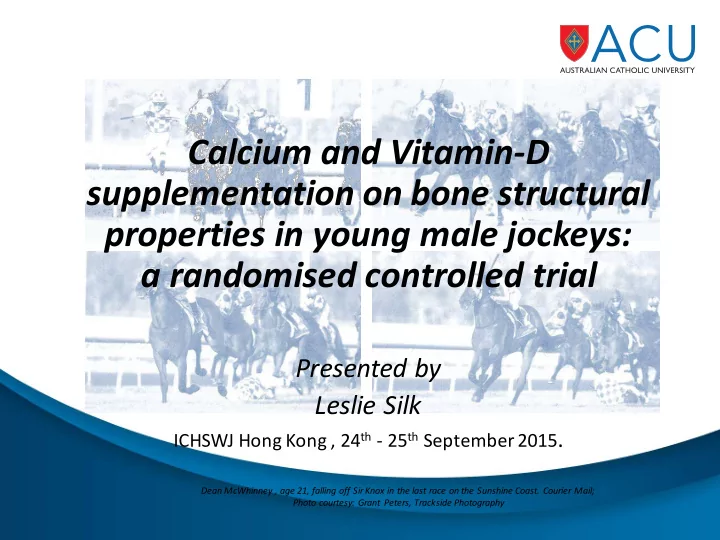

Calcium and Vitamin-D supplementation on bone structural properties in young male jockeys: a randomised controlled trial Presented by Leslie Silk ICHSWJ Hong Kong , 24 th - 25 th September 2015 . Dean McWhinney , age 21, falling off Sir Knox in the last race on the Sunshine Coast. Courier Mail; Photo courtesy: Grant Peters, Trackside Photography
Introduction • Weight restricted sport Ø no defined competition season (Hitchens, et al, 2011) Ø lowest 5 th percentile (Kuczmarski et al, 2000) Ø train >24hrs per week ( Greene, et al, 2013) • Disordered eating and dehydration (Cotugna, et al, 2011; Dolan et al, 2011; Greene, et al, 2013; Leydon & Wall, 2002; Moore et al, 2002) Bad for growing bones
Introduction • Evidence of poor bone health Ø Osteopenia Ø Reduced bone strength in Apprentices Ø Bone turnover markers elevated Higher fracture risk
Introduction • Low calcium intakes (Dolan et al, 2011 ; Greene et al, 2013; Leydon & Wall, 2002) • vitamin D insufficiency • Supplementation? Ø calcium and vitamin D (Abrahamsen et al, 2010; Chung et al, 2009; Cranney et al, 2007; Shea et al, 2002; Tang, et al, 2007; Silk et al 2015; Winzenberg et al, 2006) Ø Few male studies Ø No athlete studies
Study Aim • To establish whether calcium and vitamin D supplementation would improve bone mineral properties of young male jockeys
Study design • Double-blind, randomised, placebo controlled trial of calcium and vitamin D supplementation • Six months duration • 29 Apprentice Jockeys • 800mg Calcium plus • Average age 20 400IU vitamin D • 17 completed study
Test variables § Primary outcome measures: § Changes to bone § Changes to serum bone markers § pQCT used to assess bone health § Alterations to cortical bone more responsive than overall bone mineral density IOF recommended bone metabolism markers: - procollagen type I N propeptide (s-PINP) - serum C-terminal telopeptide of type I collagen (s-CTX)
Secondary measures Ø Serum Vitamin D Ø Full Anthropometric profile Ø Hydration status Ø Dietary Questionnaire Ø Lifestyle Questionnaire Ø Energy expenditure estimates
Baseline data Supplement Placebo group (n=8) group (n=9) (SD) p-value Mean (SD) Mean Age (yrs) 22.3 5.0 19.3 1.8 0.152 Height (cm) 165.6 4.4 167.3 4.3 0.517 Weight (kg) 52.7 3.6 52.6 3.3 0.453 Sum of six skinfolds (mm) 34.4 5.9 32.9 5.1 0.588 Hydration levels (U sg ) 1.022 0.01 1.020 0.01 0.348 Energy intake (kJ·day -1 ) 7,723 2,974 8,700 2,454 0.469 Calcium intake (mg·day -1 ) 669.7 274.3 790.4 423.9 0.503 25OH Vit D (nmol/L) 64.6 19.5 81.2 24.4 0.146
pQCT bone results Variable % difference in p- Supplemented value group Tibia 66% site Cortical content (mg·mm) 6.6 <0.001 5.9 <0.001 Cortical area (mm 2 ) 1.3 0.001 Cortical density (mg·cm 2 ) 4.0 0.003 Total area (mm 2 ) Radius 8.6 0.028 4% Trabecular area (mm 2 ) 10.0 0.003 66% Cortical area (mm 2 )
Blood results Variable % difference in p-value Supplemented group CTX -24.8 0.011 P1NP 5.0 0.511 25 (OH) Vitamin D 18.1 0.014
Secondary measure results • Anthropometric variables Ø Sum of six skinfold measures 32.9 to 34.4mm Dietary Habits • Ø Average intake 144-152kj per kg body weight Ø Calcium intake 670-790mg • Lifestyle Questionnaire Ø smoking (33%) and regularly drinking alcohol (72%) Ø 60% reported previous fractures J Barbour, the jockey who rode Apsley to a Grand National Steeplechase win at Flemington in 1894, weighs in after the race. National Museum of Australia
Bone geometry Endocortical radius (mm):
Bone geometry Pericortical radius (mm):
Cortical distribution Placebo group Supplement group Anterior 980.57 Latera l Medial 1181.84 1264.76 Posterior
Cortical distribution Supplement group vBMD p=0.09 980.57 p=0.08 p=0.07 1181.84 p=0.02 p=0.03 Mineral mass 1264.76
Conclusions • Improvements in both tibia and radius • Viable strategy for improving bone health • Study size small • Short duration
With thanks • Australian Jockey Association • Racing NSW • Racing Victoria • USANA Health Sciences Inc
Recommend
More recommend